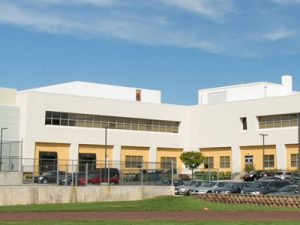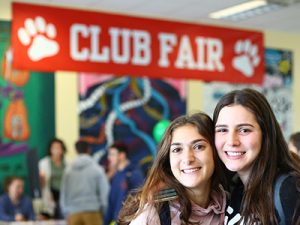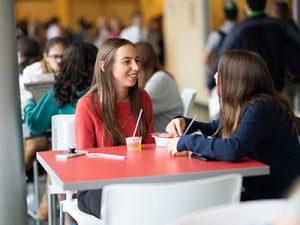Art
The Visual Arts Track is a four-year course of study, developed by our Director of Visual Arts, Mrs. Ahuva Winslow. The track provides a dynamic curriculum within an environment conducive to artistic risk-taking and student expression. It enables students to acquire the skills necessary for lifelong artistic learning and application. The Arts Program accommodates individual learning styles and develops students’ skills working in a variety of techniques. A special component of this track is the Artists’ Beit Midrash, a weekly program that combines textual learning of Jewish and biblical sources, philosophical discussions, and inquiry-based study, followed by the transposition of those thoughts and ideas into visual works of art. Students have the opportunity to learn from contemporary artists and lecturers through the program and gain exposure to many art related opportunities and experiences. Implementing the elements and principles of design, students in the Visual Arts Track create a portfolio of work of the highest standard.
Visual Arts Track Curriculum
Foundations of Design
Semester 1: Foundations of 2-D Design
Students are introduced to the foundational elements of design: line, shape, color, value, form, space, and texture, as well as the principles of design: balance, unity, emphasis, proportion, rhythm, and movement. They work with a variety of 2-D media such as charcoal, pencil, color pencil, pastel, and watercolor. Projects include still life rendering as well as assignments in fashion illustration, textile design, and graphic design.
Semester 2: Foundations of 3-D Design
Students learn how to plan, design, and construct a variety of three dimensional objects, while gaining an appreciation for the application of the elements and principles of design within the world and with multicultural and art historical themes. A variety of materials are used, such as fabric, clay, paper, and 3-D printing.
Line, Value, Shape, Texture, and Space
Semester 1: Drawing Studio
Students develop the fundamentals introduced in 2-D design, with attention to creative ideas and problem solving. Emphasis is on drawing from life, figure drawing, and portraiture, “plein air”landscape drawing, and abstraction as it relates to mark making and texture.
Semester 2: Printmaking and Graphic Design
Students learn the history, technique, and process of creating images from a prepared surface and are introduced to linocuts, woodcuts, monotype, and collagraph printmaking. The process of printmaking bridges the gap between graphic and fine art forms.
Design assignments include tutorials in using Adobe Photoshop and Illustrator.
Using Color to Create Balance, Unity, Rhythm & Movement
Semester 1: Painting Studio
Students develop painting skills and an appreciation of visual observation as they explore a variety of painting media such as watercolor, acrylic, oil sticks, and mixed media. The course emphasizes the cultivation of personal style and aesthetic understanding through student research, study, and oral presentations about historical and contemporary artists.
Semester 2: Modern Art and Design Understanding
Students have the opportunity to analyze, create, interpret, and reflect on works of modern art, including works of photography, graphic design, fashion design and advertising. Their projects force them to think deeper and create more conceptual works of art. They then study a variety of works of art that exemplify good design and use them to formulate and formalize their own personal design style. Their final project involves market research, strategic planning, and branding to create a series of print media and web design products with which consumers can identify and which promotes themselves as artists. Motivated and skilled students may gain further access to the industry through internships and mentors.
Junior Electives
Digital Media Creation
Students learn the foundational graphic design principles (fonts, colors, images, backgrounds, and layouts) needed to create and edit images – pixel-based, as well as vector artwork – using programs including Adobe Photoshop and Illustrator. They create effective graphics, posters, flyers, and other custom designs working with layers, infographics, tracing artwork, and more. Additionally, students are introduced to animation, audio production, video production, broadcasting and web design, using programs like Final Cut Pro and Wirecast Pro. This course complements Cougar Nation Network’s live broadcast, enabling students to utilize their graphics and broadcast their video projects to the Network’s audience.
Studio Art
Students are introduced to the basic elements of design, the building blocks to all art disciplines, including line, shape, value, form, space, and color and texture using a variety of drawing and painting media.
Semester 1: College Portfolios/Artist Beit Midrash/Modern Art History
Applying all design concepts introduced from 9th-11th grade, students prepare a college portfolio. Class projects challenge students to combine their knowledge developed in the Artist Beit Midrash and in Art History to create sophisticated artwork that reflects students’ growth, identity, and ideology.
Semester 2: Collaboration/Exploration/Concentration
New media are explored as students collaborate on big idea projects. Each student completes senior year with a body of work that concentrates on a chosen theme, explored in a variety of different ways.
Senior Electives
Biblical Portraits: Artist Beit Midrash (Art Pre-req)
Beginning with Sefer Yehoshua and continuing through the Megillot, students learn about characters in Nach who teach unique lessons of character and morality, through textual study, reflection, chavruta and individual work. Project-based art assignments enable students to reflect upon their personal understanding and illustration of the biblical texts and are presented to a group of teachers for critique.
Art History
The Art History course gives students the foundation needed to study and discuss art from all over the world, from prehistoric times to today. Its curriculum includes the study of architecture, sculpture, the pictorial arts – painting, drawing, printmaking and photography – and the craft arts. The course offers a sweeping survey of the handicrafts of mankind from ancient civilizations to the modern world. It engages students at the same level as an introductory college art history course, developing students’ skills in visual, contextual and comparative analyses, and prepares them for the Advanced Placement Art History exam.
Mixed Media: Studio Art
Students learn ceramics, relief sculpture, and figurative work, including linoleum cut printmaking, and silk-screening on all types of materials along with traditional drawing, painting, and collage.
Animation Basics
An overview of animation and storytelling concepts. Students learn 3-D design techniques to create unique designs and creative characters for special effects for films, games and other graphic-based media.
Digital Modeling/3D Printing
Students learn how to use texture and light to create realistic effects and characters on a 2-D screen and other techniques employed by 3-D designers. 3-D printing is also implemented to create models of student designs and concepts.
Game Animation and Motion Effects
Students use geometric shapes and concepts when creating realistic characters, landscapes, buildings, and maps and learn to manipulate images to make the objects, characters, and landscape look as if they are moving. Emphasis is placed on character creation, and creating skin and developing joints to make the characters appear life-like.
Sewing Club
Learn to sew professional looking clothing in no time with Belle Mell. Beginners will learn sewing skills that establish a solid foundation on which to build. First projects include designing and constructing a skirt and t-shirt using knit fabrics. Advanced students are introduced to woven fabrics, are taught to create darts, put in invisible zippers, set in sleeves and create a variety of hems, among other skills. Individualprojects are chosen with guidance, and essentially, students are given theskills to bring their designs to life and produce quality garments. Their broad spectrumof skills will take them to limitless heights in their sewing careers and provide a solidfoundation for entry into the world of fashion.





